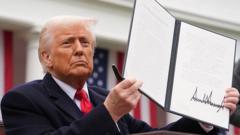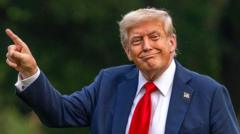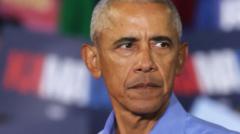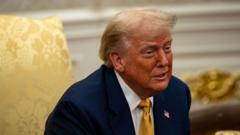The US has finalized a trade deal with Japan, which could set a precedent for other nations amid ongoing tariff battles. As Japan navigates negotiations under pressure from rising US tariffs, the implications of this agreement extend beyond bilateral trade, impacting global economic relations.
Japan Strikes Trade Deal with US Amidst Heightened Tariffs

Japan Strikes Trade Deal with US Amidst Heightened Tariffs
The recent trade agreement between Japan and the US highlights the shifting dynamics of international trade as President Trump's tariff policies begin to yield results.
The recent trade agreement between the United States and Japan is being perceived as a significant victory for President Donald Trump’s controversial tariff strategies, as they reshape the global trading landscape. After months of tense negotiations, Japan has secured what is currently the most favorable trade deal among major nations that hold a trade surplus with the US—the agreement includes a tariff of 15% on Japanese imports, which is comparatively higher than the tariff placed on the UK’s exports, given that the UK lacks similar trade surpluses.
In the backdrop of these negotiations, Japan’s finance minister had made headlines by referencing the nation’s substantial holdings, worth $1.1 trillion in US Treasury bonds—the largest in the world—as a strategic bargaining chip. The initial reluctance of Japan to commit to an agreement highlighted the nation’s hardball approach, which drew attention from negotiators in Washington known for their diplomatic finesse.
The timing of this trade deal coincides with Japan hosting EU leaders for talks, which may dampen any potential coordinated retaliation against the US from Western allies who are currently feeling the pressure. Under this agreement, while Japan has successfully safeguarded a significant portion of its agricultural imports, it is also poised to increase its purchase of US rice. However, concerns remain regarding the low demand for American automobiles in Japanese markets, despite plans for Japanese firms to invest heavily in US sectors, estimated at about half a trillion dollars.
Political motivations within Japan may have accelerated this deal as Prime Minister's domestic challenges loom large, while other countries—such as Indonesia and the Philippines—have also reached similar agreements, marking a new era of trade negotiations under heightened tariff threats.
Currently, tariff revenues are contributing significantly to the US Treasury, with estimates suggesting that around $300 billion may be collected annually—a stark contrast to historical revenue collected from tariffs. Notably, however, these tariffs do not come without costs; it’s expected that US consumers will ultimately bear the brunt of these increased import prices.
Interestingly, the US dollar has depreciated by 10% against a basket of currencies this fiscal year, adding further complications to import costs despite analyst projections that a stronger dollar would mitigate tariff impacts. This reality has prompted market shifts, with speculations about the evolving role of the dollar as a safe haven amidst weakening patterns in its demand.
In the broader context, this initial success with Japan could bolster the US's position in ongoing global trade tensions. However, as nations assess the volatile landscape created by these tariffs, the implications for international relationships and market stability remain complex and uncertain.




















